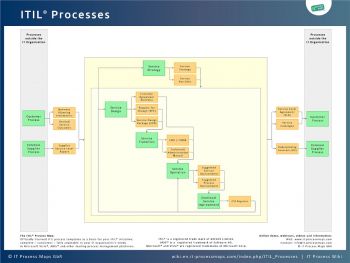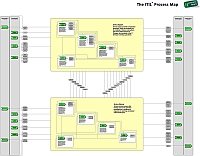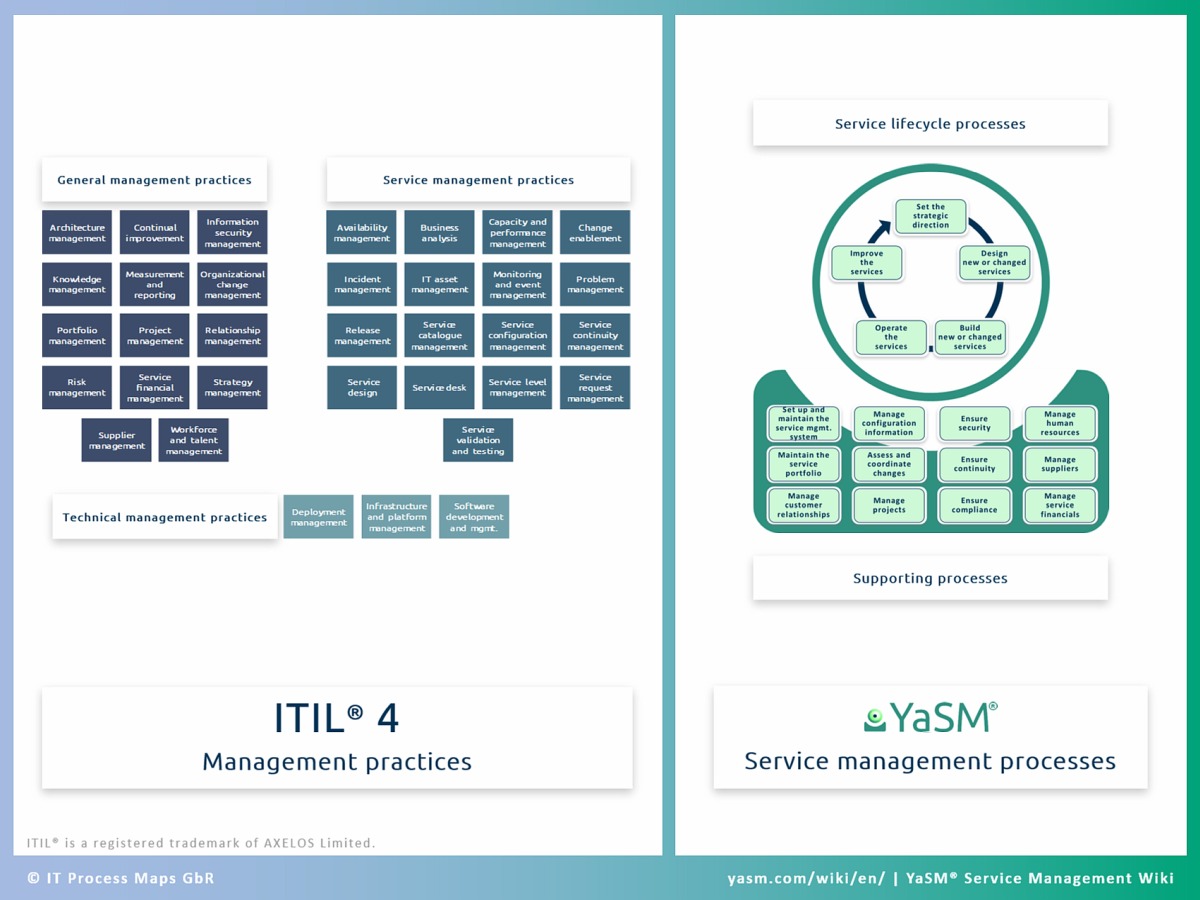ITIL Processes: Difference between revisions
No edit summary |
No edit summary |
||
| Line 23: | Line 23: | ||
</itpmch> | </itpmch> | ||
<imagemap> | <imagemap> | ||
Image:ITIL-Wiki-de-es.jpg|right|DE - ES - ITIL Processes - Processes ITIL V3|163px | |||
Image:ITIL-Wiki-de-es.jpg|DE - ES - ITIL Processes - Processes ITIL V3|163px | |||
rect 81 0 114 36 [https://wiki.de.it-processmaps.com/index.php/ITIL-Prozesse diese Seite auf Deutsch] | rect 81 0 114 36 [https://wiki.de.it-processmaps.com/index.php/ITIL-Prozesse diese Seite auf Deutsch] | ||
rect 115 0 163 36 [https://wiki.es.it-processmaps.com/index.php/Procesos_ITIL esta página en español] | rect 115 0 163 36 [https://wiki.es.it-processmaps.com/index.php/Procesos_ITIL esta página en español] | ||
| Line 47: | Line 41: | ||
<html></p><div class="thumb tright"><div class="thumbinner" style="width:352px;"><a href="https://yasm.com/wiki/en/img/yasm-frameworks/itil/itil-4-processes-yasm.jpg"><img alt="'ITIL V4 processes': ITIL 4 process management based on service lifecycle and support processes from the YaSM process model." title="ITIL processes (ITIL V4) based on YaSM service management" src="https://yasm.com/wiki/en/img/yasm-frameworks/itil/itil-4-processes-yasm.jpg" width="350" height="263" class="thumbimage" /></a> <div class="thumbcaption">Fig. 1: <a href="https://yasm.com/wiki/en/img/yasm-frameworks/itil/itil-4-processes-yasm.jpg">'ITIL V4 Processes' based on YaSM</a><br/>(Source: <a class="external text" href="https://yasm.com/wiki/en/index.php/YaSM_and_ITIL" title="ITIL processes (ITIL V4) based on YaSM service management">YaSM<sup><small>®</small></sup> Service Management Wiki </a>)</div></div></div><p></html> | <html></p><div class="thumb tright"><div class="thumbinner" style="width:352px;"><a href="https://yasm.com/wiki/en/img/yasm-frameworks/itil/itil-4-processes-yasm.jpg"><img alt="'ITIL V4 processes': ITIL 4 process management based on service lifecycle and support processes from the YaSM process model." title="ITIL processes (ITIL V4) based on YaSM service management" src="https://yasm.com/wiki/en/img/yasm-frameworks/itil/itil-4-processes-yasm.jpg" width="350" height="263" class="thumbimage" /></a> <div class="thumbcaption">Fig. 1: <a href="https://yasm.com/wiki/en/img/yasm-frameworks/itil/itil-4-processes-yasm.jpg">'ITIL V4 Processes' based on YaSM</a><br/>(Source: <a class="external text" href="https://yasm.com/wiki/en/index.php/YaSM_and_ITIL" title="ITIL processes (ITIL V4) based on YaSM service management">YaSM<sup><small>®</small></sup> Service Management Wiki </a>)</div></div></div><p></html> | ||
<html><span id="md-webpage-description" itemprop="description">While earlier versions of ITIL defined specific sets of processes, <a href="https://wiki.en.it-processmaps.com/index.php/ITIL_4" title="What is ITIL V4?">ITIL 4</a> describes 34 'practices'. This gives organizations more freedom to design tailor-made ITIL processes, in line with their specific requirements.</span></html> | <html><span id="md-webpage-description" itemprop="description">While earlier versions of ITIL defined specific sets of processes, <a href="https://wiki.en.it-processmaps.com/index.php/ITIL_4" title="What is ITIL V4?">ITIL 4</a> describes 34 '<a href="https://wiki.en.it-processmaps.com/index.php/ITIL_4#ITIL_4_management_practices" title="ITIL practices">practices</a>'. This gives organizations more freedom to design tailor-made ITIL processes, in line with their specific requirements.</span></html> | ||
The [[#ITIL_Processes_according_to_ITIL_V3|5 ITIL stages and 26 ITIL V3 processes]] have not been invalidated with the publication of ITIL 4 and they are still widely used. | The [[#ITIL_Processes_according_to_ITIL_V3|5 ITIL stages and 26 ITIL V3 processes]] have not been invalidated with the publication of ITIL 4 and they are still widely used [[#ITIL-processes-video|[1]]]. | ||
<html>But the arrival of ITIL 4, with its strong preference for reduced complexity and 'simple and practical solutions', provides an opportunity for a fresh start with leaner ITIL processes that are easier to use.</p> | <html>But the arrival of ITIL 4, with its strong preference for reduced complexity and 'simple and practical solutions', provides an opportunity for a fresh start with leaner ITIL processes that are easier to use.</p> | ||
| Line 110: | Line 104: | ||
<br style="clear:both;"/> | <br style="clear:both;"/> | ||
== | ==Video and notes== | ||
<html><span id="ITIL-processes-video">[1] Video: <a href="https://demo.it-processmaps.com/itil-4-process-map/itil-4-process-templates.html" title="Video: ITIL processes and templates for ITIL 4">ITIL 4 Process Map</a> - How service providers define ITIL processes that are in tune with ITIL 4.</span></p> | |||
< | <p>Is based on: <a href="https://en.it-processmaps.com/products/itil-process-map.html" title="The ITIL Process Map: Reference Process Model - ITIL V3" class="external text">ITIL reference processes from the ITIL Process Map</a></p> | ||
<p>By:  Stefan Kempter <a rel="author" href="https://www.linkedin.com/in/stefankempter"><img style="margin:0px 0px 0px 0px;" src="/images/bookmarking/linkedin.png" width="16" height="16" title="By: Stefan Kempter | Profile on LinkedIn" alt="Author: Stefan Kempter, IT Process Maps GbR" /></a>, IT Process Maps.</p> | <p>By:  Stefan Kempter <a rel="author" href="https://www.linkedin.com/in/stefankempter"><img style="margin:0px 0px 0px 0px;" src="/images/bookmarking/linkedin.png" width="16" height="16" title="By: Stefan Kempter | Profile on LinkedIn" alt="Author: Stefan Kempter, IT Process Maps GbR" /></a>, IT Process Maps.</p> | ||
Revision as of 12:59, 7 March 2022

Objective: IT service providers implement ITIL processes to ensure their services are delivered in a customer-focused, quality-driven and economical way.
ITIL 4 Processes
While earlier versions of ITIL defined specific sets of processes, ITIL 4 describes 34 'practices'. This gives organizations more freedom to design tailor-made ITIL processes, in line with their specific requirements.
The 5 ITIL stages and 26 ITIL V3 processes have not been invalidated with the publication of ITIL 4 and they are still widely used [1].
But the arrival of ITIL 4, with its strong preference for reduced complexity and 'simple and practical solutions', provides an opportunity for a fresh start with leaner ITIL processes that are easier to use.
We describe such a leaner set of 19 service management processes in the YaSM Wiki.
ITIL Processes according to ITIL V3

ITIL V3 (ITIL 2011) organizes the ITIL processes around the five service lifecycle stages: Service Strategy, Service Design, Service Transition, Service Operation, and Continual Service Improvement (see fig. 2). Each of the five stages is focused on a specific phase of the service lifecycle:
- Service Strategy
- Process Objective: To decide on a strategy to serve customers. Starting from an assessment of customer needs and the market place, the Service Strategy process determines which services the IT organization is to offer and what capabilities need to be developed. Its ultimate goal is to make the IT organization think and act in a strategic manner.
- Service Design
- Process Objective: To design new IT services. The scope of the process includes the design of new services, as well as changes and improvements to existing ones.
- Service Transition
- Process Objective: To build and deploy IT services. Service Transition also makes sure that changes to services and Service Management processes are carried out in a coordinated way.
- Service Operation
- Process Objective: To make sure that IT services are delivered effectively and efficiently. The Service Operation process includes fulfilling user requests, resolving service failures, fixing problems, as well as carrying out routine operational tasks.
- Continual Service Improvement - CSI
- Process Objective: To use methods from quality management in order to learn from past successes and failures. The Continual Service Improvement process aims to continually improve the effectiveness and efficiency of IT processes and services, in line with the concept of continual improvement adopted in ISO 20000.
ITIL Processes according to ITIL Version 2 (ITIL V2)

Unlike ITIL V3, IT Service Management according to ITIL version 2 was not organized around the service lifecycle. ITIL V2 included two "disciplines":
- Service Support
- The ITIL discipline Service Support provides all operative Processes necessary for the handling of Service interruptions and for the implementation of Changes; the availability of the IT Services is thereby guaranteed.
- Service Delivery
- The ITIL discipline Service Delivery ensures that binding rules for the operative Processes are in existence. It regulates the planning, contractual and financial topics.
Video and notes
[1] Video: ITIL 4 Process Map - How service providers define ITIL processes that are in tune with ITIL 4.
Is based on: ITIL reference processes from the ITIL Process Map
By: Stefan Kempter ![]() , IT Process Maps.
, IT Process Maps.
Service Strategy › Service Design › Service Transition › Service Operation › Continual Service Improvement







